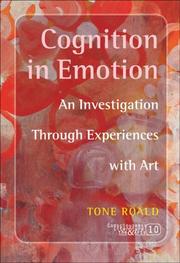| Listing 1 - 4 of 4 |
Sort by
|

ISBN: 9401205345 1435613295 9781435613294 9042023333 9789042023338 9042023333 9789042023338 9789401205344 Year: 2007 Publisher: Amsterdam New York, NY Rodopi
Abstract | Keywords | Export | Availability | Bookmark
 Loading...
Loading...Choose an application
- Reference Manager
- EndNote
- RefWorks (Direct export to RefWorks)
Emotions are essential for human existence, both lighting the way toward the brightest of achievements and setting the course into the darkness of suffering. Not surprisingly, then, emotion research is currently one of the hottest topics in the field of psychology. Yet to divine the nature of emotion is a complex and extensive task. In this book emotions are approached thought an exploration of the nature of cognition in emotion; the nature of thoughts in feelings. Different approaches to emotions are explored, from brain research to research at the level of experience, and it is argued that all approaches must seriously take into account the experiential dimension. A qualitative study of experiences with art is therefore presented, as emotions and cognition are often expressed in experiences with art. It is the first study of its kind. Descriptions of various affective phenomena are then given which have significant implications for contemporary debates about emotions, resolving several contemporary controversies.
Emotions and cognition. --- Emotions in art. --- Art --- Cognition and emotions --- Cognition --- Psychology.
Book
ISBN: 9789042036345 9042036346 9789401209045 9401209049 1322244820 Year: 2013 Volume: 32 Publisher: Amsterdam
Abstract | Keywords | Export | Availability | Bookmark
 Loading...
Loading...Choose an application
- Reference Manager
- EndNote
- RefWorks (Direct export to RefWorks)
Art has the capacity to shape and alter our identities. It can influence who and what we are. Those who have had aesthetic experiences know this intimately, and yet the study of art’s impact on the mind struggles to be recognized as a centrally important field within the discipline of psychology. The main thesis of Art and Identity is that aesthetic experience represents a prototype for meaningful experience, warranting intense philosophical and psychological investigation. Currently psychology remains too closed-off from the rich reflection of philosophical aesthetics, while philosophy continues to be sceptical of the psychological reduction of art to its potential for subjective experience. At the same time, philosophical aesthetics cannot escape making certain assumptions about the psyche and benefits from entering into a dialogue with psychology. Art and Identity brings together philosophical and psychological perspectives on aesthetics in order to explore how art creates minds.
Artists --- Artistes --- Psychology. --- Psychologie --- Artists -- Psychology. --- Couples -- Psychology. --- Creation (Literary, artistic, etc.). --- Philosophy --- Visual Arts --- Art, Architecture & Applied Arts --- Philosophy & Religion --- Aesthetics --- Visual Arts - General --- Psychology --- Creation (Literary, artistic, etc.) --- Identity (Psychology) in art. --- Creative ability in art --- Creative ability in literature --- Art --- Imagination --- Inspiration --- Literature --- Creative ability --- Originality
Book
ISBN: 9004309012 Year: 2015 Publisher: Leiden, Netherlands ; Boston, [Massachusetts] : Brill Rodopi,
Abstract | Keywords | Export | Availability | Bookmark
 Loading...
Loading...Choose an application
- Reference Manager
- EndNote
- RefWorks (Direct export to RefWorks)
How does art influence us? In The Subject of Aesthetics , Tone Roald approaches aesthetics as a psychological discipline, showing how works of art challenge our habitual ways of perceiving the world. While aesthetics has traditionally been a philosophical discipline, Roald discusses how it is very much alive in the realm of psychology – a qualitative psychology of lived experience. But what actually constitutes an aesthetics of lived experience? The book answers that question by analyzing people’s own engagement with visual art. What emerges is that the object of aesthetics is indeed the subject.
Book
ISBN: 9789004308718 Year: 2015 Publisher: Leiden ; Boston Brill
Abstract | Keywords | Export | Availability | Bookmark
 Loading...
Loading...Choose an application
- Reference Manager
- EndNote
- RefWorks (Direct export to RefWorks)
| Listing 1 - 4 of 4 |
Sort by
|

 Search
Search Feedback
Feedback About UniCat
About UniCat  Help
Help News
News